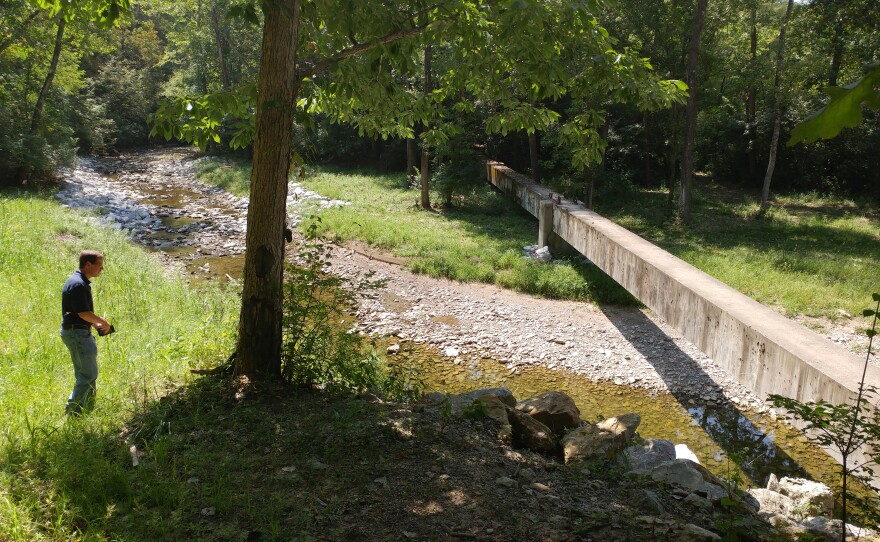A nameless creek winds its way north through Clermont County, from Miami Township to Loveland.
Just before it spills into O'Bannon Creek, it takes a couple of hard turns, forming a horseshoe. This bend in the river doesn't seem all that important. The nearest homes are a couple hundred yards away, and upstream. You can't hear traffic and there's only one obviously man-made object in sight.
Stretching across the river, like a thin footbridge, there's a grey concrete beam. It's about 3 feet above the streambed. It comes out of the woods on the far side of the creek and disappears into a hillside.
"This is an aerial sewer crossing that comes into the sewage treatment plant up the hill. Before the project, the stream was in a really unstable form," says John McManus. He is the Clermont County Soil and Water Conservation District administrator, and helped change the bend in the creek. McManus says a lot of water and debris will move through this valley after a big rainstorm and that was a threat to the sewer crossing.
"Around five years ago, something came down. It buckled it a little bit, it didn't break. Thank God. But we thought 'we gotta do something with this creek to put it in a more stable form.'"
McManus's job is, in part, to give advice on the best practices for keeping soil healthy, and water clean. The district was first formed 75 years ago, but McManus says its roots go back further than that. "Soil and water conservation districts were formed out of the Dust Bowl, in the 1930s," he says.
Farmers grew too much wheat during the Depression to make up for lost profits. When drought hit, wind carried a lot of topsoil away. After the federal government passed the Soil Conservation Act, states authorized the creation of conservation districts.
In 1943, Clermont County was nearly all rural and agricultural. The population was about a sixth of what it is today. McManus says the district's focus then was on improving drainage and preventing soil erosion. His office still helps farmers with those issues today.

He says a lot of their work is around East Fork Lake. "Which is not only used heavily for recreation, but it also serves as a drinking water source for half the county. And since about 2010, we've been experiencing problems with harmful algal blooms." McManus says the blooms are caused by nitrogen and phosphorus getting into the lake. "There's a number of different sources: sewage treatment plants and failing septic systems, but agriculture is a big part of that."
McManus says the district works with farmers to reduce runoff from their fields. "We are not a regulatory agency. Everything we do is through education."
Clermont County isn't the same place it was 75 years ago. With increased development, McManus says the district has had to expand its focus. "When you go from open ground to hard surfaces, such as roads and rooftops and parking lots, that sends a lot more water to the streams a lot quicker. That extra flow and extra volume causes the streams to erode themselves."
Not unlike that unnamed tributary outside Loveland. McManus says with the Clermont County Water Resources Department, and a grant from the EPA, they softened the curve that was approaching the sewage lines and created a small flood plain. "What a flood plain does is great is it helps take energy out of a stream. Because when it comes up, if it's confined in a valley and the stream comes up, it stays within that valley and is really erosive on the banks. If it can reach a flood plain, it spreads out and when it spreads out it slows down."
Slower water means slower debris, which keeps the sewage lines secure.
Work started on this project in December, 2017 and ended in spring 2018. It cost about $155,000 to change the course of the stream. He says that's a lot less expensive than digging new sewer lines beneath the creek.





